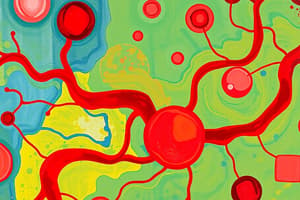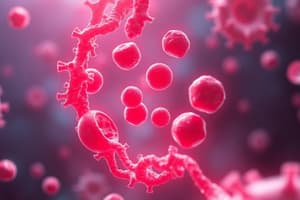Podcast
Questions and Answers
What is the primary role of thrombopoietin in hemostasis?
What is the primary role of thrombopoietin in hemostasis?
- Increases platelet numbers (correct)
- Activates clotting factors
- Decreases platelet aggregation
- Promotes vasodilation
What initiates the vascular phase of hemostasis?
What initiates the vascular phase of hemostasis?
- Clotting factor activation
- Platelet aggregation
- Vasodilation
- Vasoconstriction (correct)
Which of the following is a substance released by platelets that attracts more platelets?
Which of the following is a substance released by platelets that attracts more platelets?
- Endothelin-1
- Thromboxane A2 (correct)
- Prostacyclin
- Nitric oxide
How does prostacyclin (PGI2) function in the context of hemostasis?
How does prostacyclin (PGI2) function in the context of hemostasis?
What is the function of von Willebrand factor in the clotting process?
What is the function of von Willebrand factor in the clotting process?
What is the effect of inadequate levels of clotting factors on hemostasis?
What is the effect of inadequate levels of clotting factors on hemostasis?
Which pathway is NOT involved in the coagulation cascade?
Which pathway is NOT involved in the coagulation cascade?
What substances are responsible for prolonging vasoconstriction during the vascular phase?
What substances are responsible for prolonging vasoconstriction during the vascular phase?
What regulates levels of factor VIII in the extrinsic pathway?
What regulates levels of factor VIII in the extrinsic pathway?
What is the primary role of Coumadin (Warfarin) in coagulation?
What is the primary role of Coumadin (Warfarin) in coagulation?
In the cell-based theory of coagulation, what initiates the process?
In the cell-based theory of coagulation, what initiates the process?
Which phase of the cell-based theory of coagulation results in the formation of large amounts of thrombin?
Which phase of the cell-based theory of coagulation results in the formation of large amounts of thrombin?
Which physiological anticoagulant is known to inhibit platelet aggregation?
Which physiological anticoagulant is known to inhibit platelet aggregation?
What is the function of tissue plasminogen activator (tPA)?
What is the function of tissue plasminogen activator (tPA)?
What occurs after healing in the context of blood clot removal?
What occurs after healing in the context of blood clot removal?
Which of the following accurately describes one pathway in the coagulation cascade?
Which of the following accurately describes one pathway in the coagulation cascade?
Flashcards
Three phases of hemostasis
Three phases of hemostasis
The three stages: vascular phase, platelet phase, and coagulation phase involved in stopping bleeding.
Vascular phase
Vascular phase
Initial response to blood vessel injury involving vasoconstriction to reduce blood flow.
Platelet phase
Platelet phase
Activation and aggregation of platelets at the site of injury, forming a temporary plug.
von Willebrand factor
von Willebrand factor
Signup and view all the flashcards
Anticoagulants
Anticoagulants
Signup and view all the flashcards
Prostaglandin I2 (PGI2)
Prostaglandin I2 (PGI2)
Signup and view all the flashcards
Thrombopoietin
Thrombopoietin
Signup and view all the flashcards
Coagulation cascade
Coagulation cascade
Signup and view all the flashcards
Extrinsic Pathway
Extrinsic Pathway
Signup and view all the flashcards
Vitamin K
Vitamin K
Signup and view all the flashcards
Intrinsic Pathway
Intrinsic Pathway
Signup and view all the flashcards
Cell-Based Theory of Coagulation
Cell-Based Theory of Coagulation
Signup and view all the flashcards
Amplification Phase
Amplification Phase
Signup and view all the flashcards
tPA (Tissue Plasminogen Activator)
tPA (Tissue Plasminogen Activator)
Signup and view all the flashcards
Antithrombin III
Antithrombin III
Signup and view all the flashcards
Study Notes
Hemostasis
- Hemostasis involves three phases: vascular, platelet, and coagulation.
- The coagulation cascade has three pathways: common, extrinsic, and intrinsic.
- Anticoagulants influence coagulation by either increasing plasmin production, blocking thrombin action, or inhibiting clotting factor synthesis.
- Clotting factors' levels impact the coagulation pathways.
- Platelets are cell fragments that are crucial for blood clotting. Their half-life is 10 days, and thrombopoietin regulates their numbers.
- Megakaryocytes are large cells with multiple DNA copies; platelets are derived from their cytoplasm.
- Platelet activation is triggered by exposed collagen, leading to aggregation and formation of a plug.
- Platelet activation also involves releasing factors to attract more platelets.
- Vasoconstriction (narrowing of blood vessels) is part of the vascular phase of hemostasis, and can be stimulated by serotonin, endothelin-1, and thromboxane A2.
- Prostacyclin and nitric oxide produced by intact endothelium prevent platelet adhesion.
- The coagulation cascade aims to form a fibrin clot to halt bleeding.
- The common pathway receives input from both extrinsic and intrinsic pathways.
- The extrinsic pathway is activated by tissue factor exposure.
- The intrinsic pathway is activated by collagen or other activators.
- Importantly, the newer cell-based model of coagulation is a more accurate representation of coagulation than the older three-pathway model.
- The cell-based theory describes three phases of coagulation: initiation, amplification, and propagation.
Hematopoiesis
- Hematopoiesis is the process of blood cell formation.
- Note the diagram showing the development of various blood cells from bone marrow, including erythrocytes, platelets, neutrophils, monocytes, basophils, eosinophils, and lymphocytes.
Platelets
- Platelets are needed for blood clotting.
- Their half-life is 10 days.
- Thrombopoietin increases platelet numbers, and megakaryocytes are the source of platelets.
Three Phases of Hemostasis
- Vascular phase: Vasoconstriction, primarily neurogenic and myogenic, is initiated by blood vessel injury. This phase is prolonged by serotonin, endothelin-1, and thromboxane A2.
- Platelet phase: This phase involves platelet activation, adherence, aggregation, and formation of a temporary hemostatic plug. Important factors are von Willebrand factor, ADP, PAF, serotonin, and thromboxane A2.
- Coagulation phase: The coagulation cascade culminates in the formation of a stable fibrin clot through a complex series of enzymatic reactions involving various clotting factors.
Coagulation Cascade Details
- Key players in the common pathway include factors X, V, II (thrombin), and XIII. These factors interact to form a cross-linked fibrin polymer that reinforces the platelet plug and stops blood loss.
- In the extrinsic pathway, tissue factor (TF) plays a central role, initiating a sequence of reactions leading to the activation of factor X and ultimately thrombin generation.
- In the intrinsic pathway, the activation of factor XII initiates a series of reactions, finally culminating in factor X activation and thrombin generation.
Removal of Clot
- After healing, the clot is removed by fibrinolysis. Plasminogen is activated to plasmin, which breaks down the fibrin polymer into fragments. tPA (tissue plasminogen activator) is released slowly by damaged endothelium to initiate this process.
Physiological Anticoagulants
- Physiological anticoagulants regulate blood clotting and prevent excessive clot formation. These include plasminogen/plasmin, tissue plasminogen activator (tPA), antithrombin III, and prostacyclin.
Cell-Based Theory of Coagulation
- This newer model emphasizes the role of cells (especially platelets and endothelial cells) in orchestrating the coagulation cascade. Critically, the initiation, amplification, and propagation phases occur on cell surfaces.
Summary
- Coagulation is a tightly regulated process involving multiple factors and steps with roles of different cells.
Studying That Suits You
Use AI to generate personalized quizzes and flashcards to suit your learning preferences.




